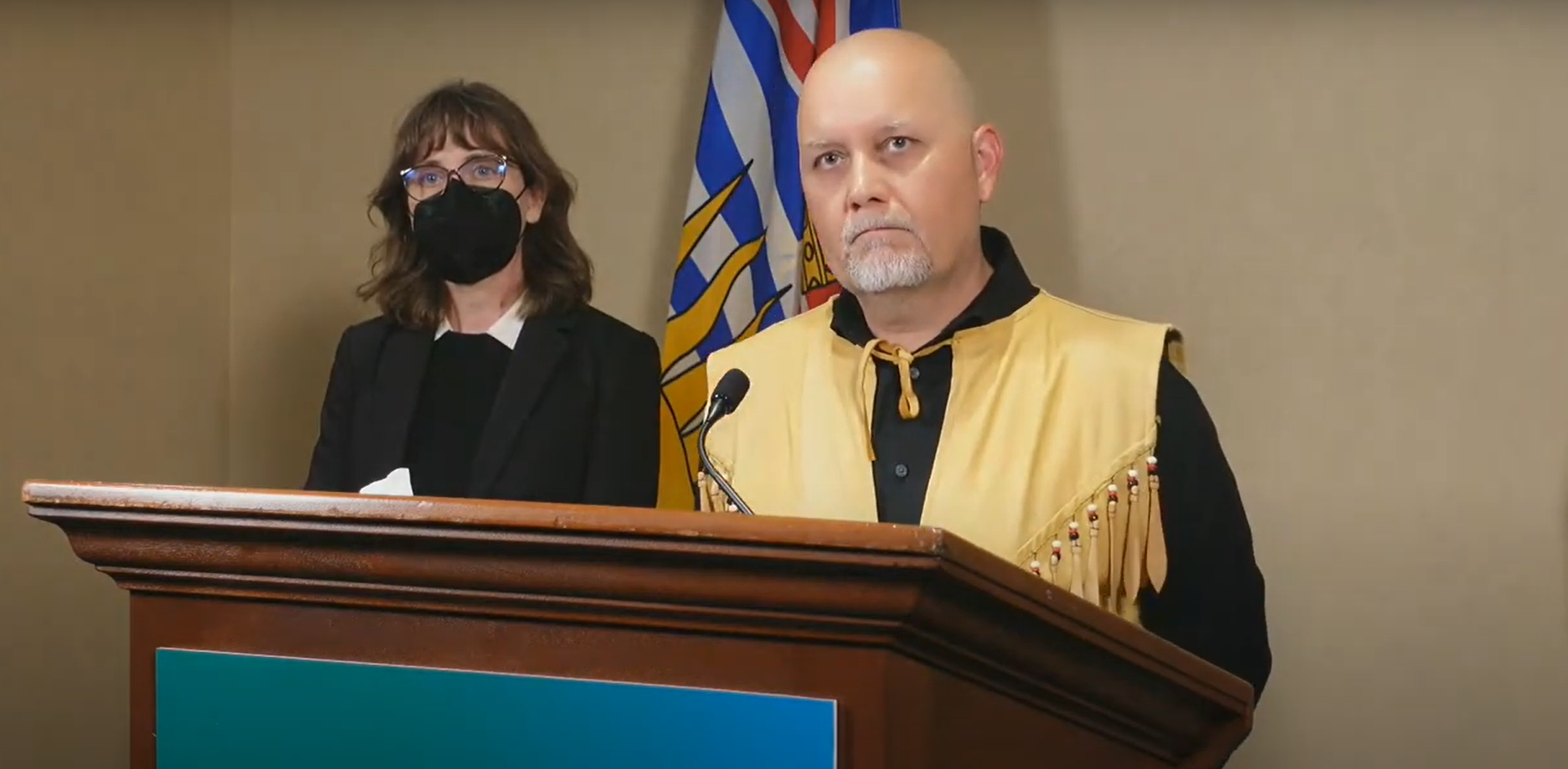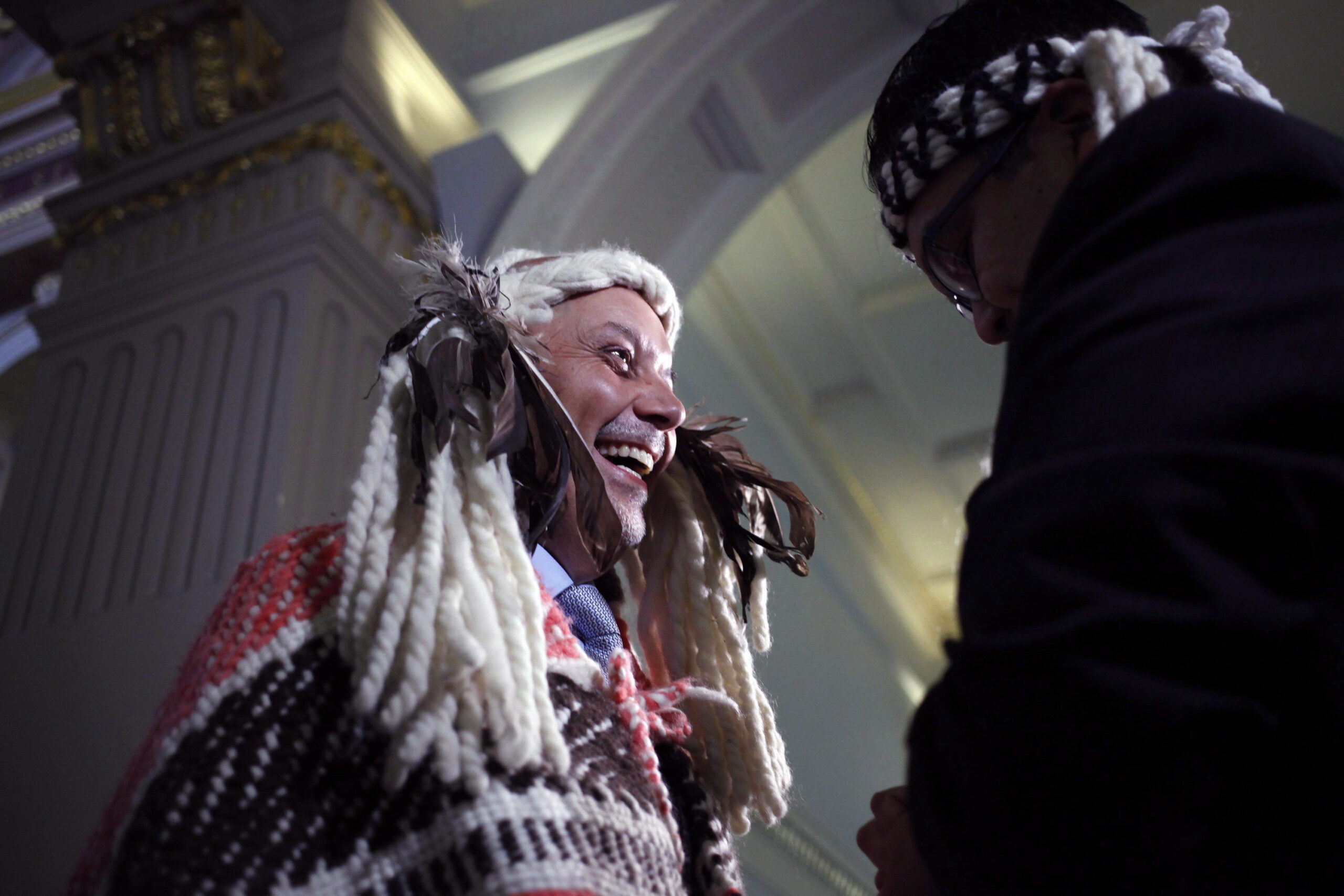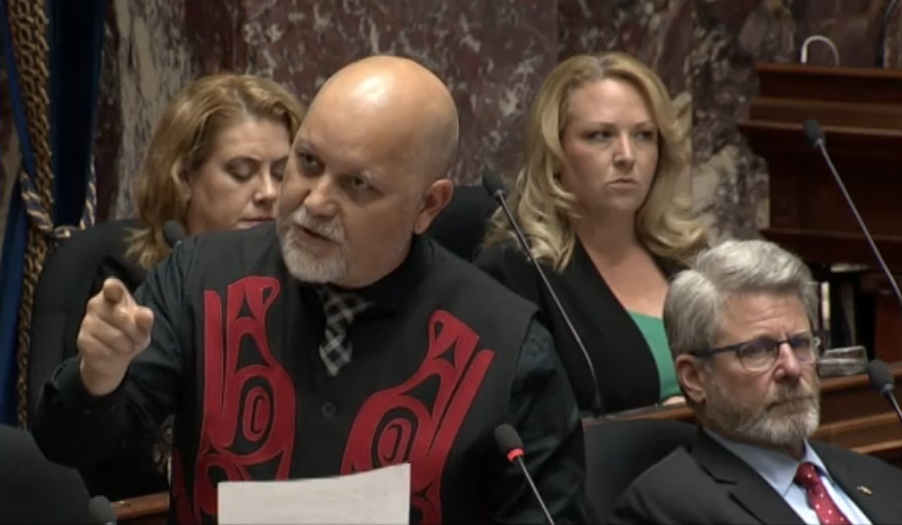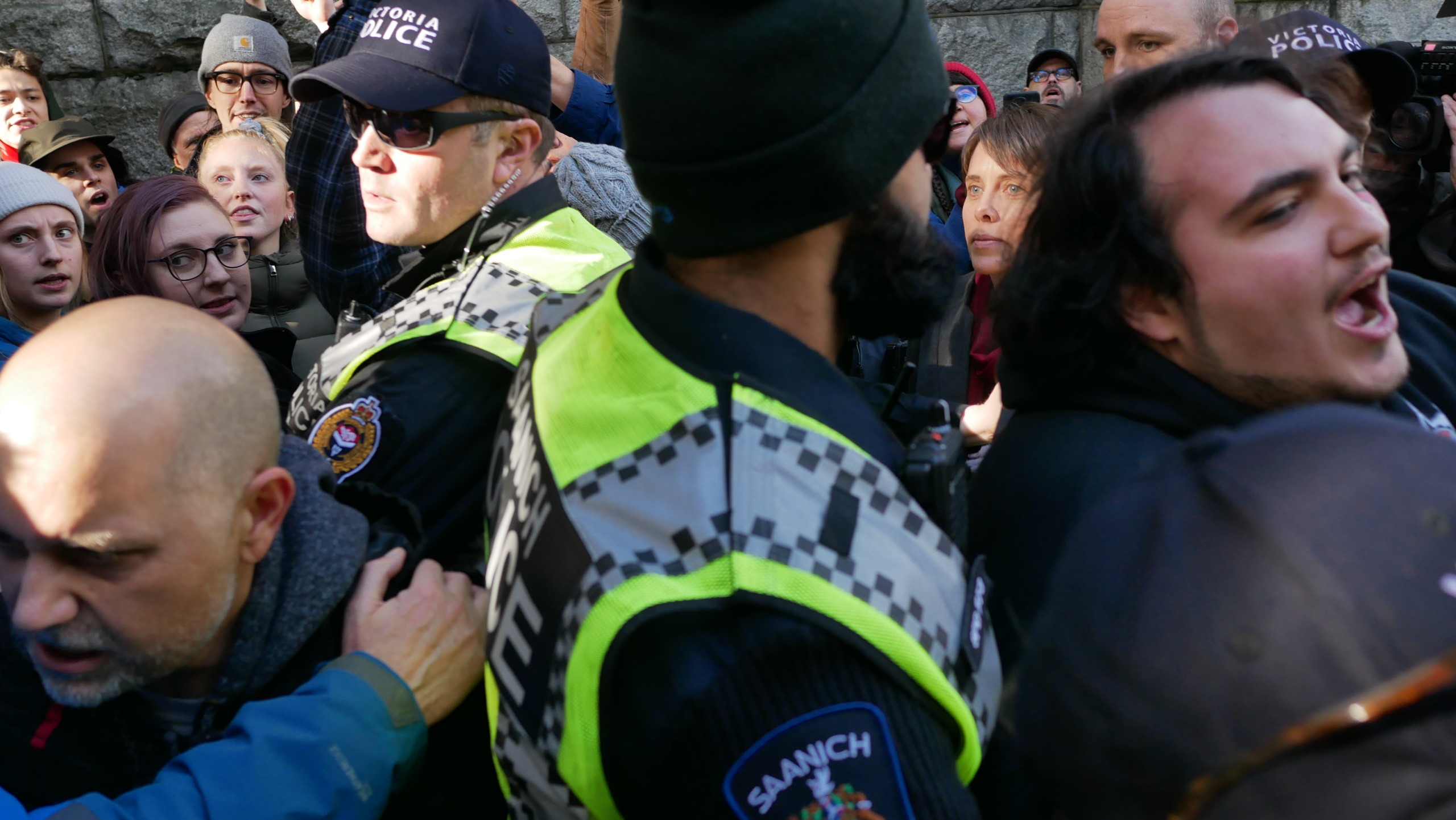
5 things to know about Winnipeg’s big sewage problem
115 billion litres, 70 years to fix, $5.5 billion in lawsuits
When Green Party MLA Adam Olsen rose in the B.C. legislature in mid-May to grill the BC NDP government over its failure to protect wild salmon, he knew it was the last time he would pose questions directly to the government as an MLA.
“My question is to the premier,” Olsen said. “When he decides to replace that mural out there in that [B.C. legislature] rotunda, the wild Pacific salmon mural, will he replace it with a fracking rig and the massive welded pipes or a hellscape of wildfires and hungry, thirsty British Columbians?”
“Will the premier lease that space out there depicting the fishing industry to the fossil fuel lobbyists for advertising so that the Minister of Energy can be very clear who’s calling the shots?” Olsen continued.
During his seven years as MLA for Saanich North and the Islands, Olsen, a member of Tsartlip First Nation, developed a reputation as a fiery and unflinching critic of the government. His final questions in the legislature were no exception. In late June, Olsen announced he will not be seeking re-election when B.C. voters go to the polls this fall, citing the impacts of his job as an MLA on his ability to spend time with his family, including his two children.
“It was not easy,” Olsen told The Narwhal of his decision. “But I’m glad to be on the other side of the announcement now and looking ahead.” Over the next few months, Olsen will serve as the BC Green Party’s campaign chair and help mentor its 2024 candidates.
Olsen’s exit comes at a pivotal moment for the Greens. It leaves party leader Sonia Furstenau as the only Green incumbent seeking re-election — and her political future is far from certain following her decision to run in Victoria-Beacon Hill, a riding where the Greens have come a distant second to the NDP since 2005. Furstenau said she made the decision to switch ridings for family reasons. Her move followed boundary changes to her Cowichan Valley riding, where she rose to notoriety by fighting the dumping of contaminated waste at a landfill near the water supply for the community of Shawnigan Lake.

“I consider it the greatest gift of the last seven years, my friendship and being able to work alongside Adam,” Furstenau said at Olsen’s June 25 announcement, describing him as “somebody who can speak from a place of integrity, a place of deep wisdom and, importantly, a place of service.”
For the past four years, Furstenau and Olsen have, for the most part, been the lone voices in the legislature holding the BC NDP to account for its environmental protection and climate action promises. They’ve delivered blistering critiques of the government’s failure to protect at-risk species such as spotted owls and what they perceive to be the BC NDP’s cozy relationship with the fossil fuel industry. In an interview, Olsen described the BC Greens as “the conscience in the legislature.”
Before the 2020 election, Olsen and Furstenau — along with former BC Green Party leader Andrew Weaver — were partners with the BC NDP through an agreement that gave the minority NDP government enough votes in the legislature to govern. During the three years the agreement lasted, the Greens successfully pushed the BC NDP government to implement what became its signature climate action plan, change the rules for political donations and keep its election promise to ask the independent BC Utilities Commission for a fast-tracked economic review of the publicly funded Site C dam. (The review found the same amount of energy could be produced from a suite of renewables, including wind power — for about one-half the dam’s current $16-billion price tag.)
The Greens also clashed with the BC NDP over old-growth logging and energy issues encompassing everything from the decision to proceed with the Site C dam despite the findings of the review to greenlighting the province’s new carbon-intensive liquefied natural gas (LNG) industry and offering highly profitable oil and gas companies billions of dollars in subsidies.
“Speaking from the perspective of the Union of BC Indian Chiefs, we have all always appreciated their two voices in the legislature in terms of keeping the government’s feet to the fire,” Grand Chief Stewart Phillip told The Narwhal. (Phillip’s spouse, Joan Phillip, is the NDP MLA for Vancouver-Mount Pleasant.)
Olsen’s departure set off a flurry of speculation in political circles about what lies ahead for the BC Greens, including dire predictions for the party’s immediate political fortunes. None of it surprised Olsen, a two-term MLA.
“There have been [people] that have been predicting our demise for years,” Olsen said.
But there are signs the party’s situation is not as bleak as some — including Weaver, who predicted the party he once led is “finished” — have suggested.
A Research Co. poll released hours ahead of Olsen’s announcement in June showed 15 per cent of decided voters in B.C. support the Green Party, an increase of three percentage points from May. It’s a level of support similar to what the party enjoyed in 2020. The poll put the Greens ahead of BC United (formerly the BC Liberals and the current official opposition), by three percentage points. According to the poll, the BC NDP are still in the lead but the BC Conservatives are closing in.
“In terms of our momentum and electoral success, we are focused on what it takes to get Greens elected,” Furstenau said following the poll’s publication. “That doesn’t happen by accident, it takes a lot of hard work.”
With more than three months to go before voting day on Oct. 19, Olsen is optimistic about his party’s chances.
“There will be a point in time when every single person is sitting in the ballot box asking themselves a question: ‘Who best is going to represent me in the legislature?’ The BC Greens, our goal, is to give them somebody to vote for that represents and reflects the values that [Furstenau] and I have been working towards for the last seven years.”

Those include traditionally “green” values like protecting and preserving ecosystems, safeguarding what remains of B.C.’s rare old-growth forests, reining in destructive resource development and reducing carbon emissions and other pollution.
The BC NDP government’s failure to follow through on its campaign promise to enact a stand-alone law to protect at-risk species and its lack of progress protecting old-growth forests were among the last issues Olsen raised in the legislature.
“Decades of industrial logging have taken an immense toll on the ecosystems and communities, and this government’s response is rhetoric,” he said in mid-May during the second-last question period of the session. “When will [this] government fully fund the deferral process and provide compensation to First Nations that lose revenue as a result of the deferrals?” Olsen asked, referring to the old-growth deferral process that relies on agreement from First Nations — many of which make money and generate employment from logging activities on their traditional territories.
Research Co. principal Mario Cansenco said the BC Green Party will always appeal to a segment of B.C. voters.
“If you’re somebody who’s looking for action on the climate change file and you’re surrounded by all of these messages related to LNG development and maybe you don’t feel like [Premier David] Eby has been strong enough on that file, you might gravitate towards the Greens,” Cansenco said in an interview.

But while dissatisfaction with the BC NDP’s pro-LNG policies and lack of timely action on environmental issues like protecting old-growth forests and at-risk species may have given the Greens an opening with some voters in the past two elections, Cansenco said the rise of the BC Conservatives could make the 2024 vote a tougher competition.
“There are a bunch of voters who are deeply disenchanted with politics. … [They’re] not necessarily an environmentally friendly voter, but somebody who’s upset with the way things are going,” Cansenco said. “Now, that type of voter … might look at the BC Conservatives in the same way: they’re fresh and they’re different.”
For other voters, the BC Conservatives’ rapid rise and the corresponding decline of BC United’s electoral chances could make the Greens an appealing option.
“I actually think that the current landscape could bode very well for the Greens,” former B.C. environment minister Mary Polak told The Narwhal. “The ordinary person is looking at this changing party landscape in British Columbia. I think that’s a recipe for a lot of voters to say, ‘Hmm, I can’t vote NDP … but I don’t know who all these yahoos are on the free enterprise side, so who am I going to vote for?’ ” Polak, a former BC Liberal MLA, said. “They might vote Green, especially if they know the local candidate.”
It could be “one weird election,” Polak added.
One of the biggest imprints the BC Greens have left on provincial policy is their contribution to the Clean BC plan. The plan launched in December 2018 with legislated targets to reduce B.C.’s greenhouse gas emissions by 40 per cent below 2007 levels by 2030. By 2050, B.C.’s goal is to cut emissions by 80 per cent through policies aimed at boosting the use of electric vehicles and reducing emissions from industry, buildings and transportation.
Political strategist Jillian Oliver, who managed the BC Greens 2020 election campaign and Furstenau’s successful leadership bid following Weaver’s departure, called Clean BC the “crown jewel” of the NDP-Green alliance era.
“I don’t think we [could have had] Clean BC without the minority government,” Oliver told The Narwhal. “It’s so comprehensive and so difficult to unwind — even though the opposition parties are threatening to do that. I think it’s going to be very difficult to dismantle.”
But for Olsen, Clean BC’s shine has tarnished with time.
He said the BC NDP has used Clean BC “as a shield and as a sword” to defend policies that benefit polluters and deflect criticism by pointing to its co-development with the BC Greens.
“The BC NDP have no legitimacy talking about climate action or their bold Clean BC plan,” Olsen added. “It’s ageing, it is out of date and it doesn’t consider all of the oil and gas and industry development that’s been encouraged and celebrated under the BC NDP.”
While the former BC Liberal government approved the LNG Canada project, Eby claimed the BC NDP government “delivered that project.” The LNG Canada production and export terminal near Kitimat is set to drive the biggest fracking boom in the province’s history, to supply enough gas to produce up to 14 million tonnes of LNG per year. In March 2023, Eby also gave the greenlight to Cedar LNG, the first Indigenous majority-owned LNG facility.
The Green caucus had input into all legislation introduced by the BC NDP government between September 2017 and May 2020 — and the power to topple the government by voting against the NDP in certain situations. They wielded significant, but often subtle, influence on the government’s agenda.
“What would have been the most influential is probably nothing that you would have seen — it would have been the absence of something,” Polak said. “There’s no doubt in my mind that would have, on a daily basis, affected the decision-making of the governing party.”
Polak served as government house leader for the BC Liberals during the minority government, a position that often placed her around a table with Furstenau, the BC Greens’ house leader, and cabinet minister Mike Farnworth, who was the NDP’s house leader during those years. Together, the three were responsible for planning and negotiating the day-to-day work of their parties in the legislature.
It was a marked departure from the previous decades, when only two political parties held seats in the legislature — forming the government and the official opposition — along with a smattering of independent MLAs. When Olsen and Furstenau were elected in 2017, joining Weaver in the legislature, it added a new layer of accountability, according to Evan Pivnick, who was chief of staff to Weaver during the minority government.
“There was unique accountability provided by BC Greens during that minority government, where three MLAs and seven staff were required to understand and provide support on every issue that passed through the legislature,” Pivnick said. “That provided an additional check that otherwise just doesn’t occur.”
Oliver said the Green Party caucus helped shift the tone of political debate.
“[They raised] the level of debate in the legislature and showed a contrast to the other opposition parties and the government, that it doesn’t need to be this sort of reductive political debate, that you can have a productive opposition that puts forward solutions, that is honest and isn’t just there to sort of play political theater,” she told The Narwhal.
Olsen said the passage of the Declaration on the Rights of Indigenous Peoples Act, known as DRIPA, was the high point of his time as an MLA.
B.C. was the first Canadian jurisdiction to enshrine the United Nations Declaration on the Rights of Indigenous Peoples into law in 2019. Grand Chief Phillip, of the Union of BC Indian Chiefs, said the province has remained ahead of the curve in acknowledging Indigenous Rights under the BC NDP.
“It’s the only jurisdiction that has been so progressive and so bold in knowing and understanding the essential need for the UN Declaration on the Rights of Indigenous Peoples to be part of any and all governance in this country,” he said.
In the years since the law was passed, Olsen has criticized the government for failing to live up to the act’s principles by supporting construction of the Coastal GasLink pipeline over the objections of Wet’suwet’en First Nation Hereditary Chiefs and matriarchs. The United Nations Committee on the Elimination of Racial Discrimination also issued a rebuke over the Coastal GasLink pipeline, calling for an immediate halt to construction until the free, prior and informed consent of Indigenous Peoples was achieved.
In February 2020, opposition to the pipeline arrived at the B.C. legislature, where supporters of the Wet’suwet’en Hereditary Chiefs and matriarchs blockaded the building and demanded MLAs respect the hereditary leaders’ position.

“[Olsen] was forced to cross the line in front of a variety of Indigenous activists,” Pivnick recalled. “He made a choice in advancing within the provincial government … the types of changes that moved us forward towards reconciliation.”
Phillip, who has a history of opposing fossil fuel projects in B.C. and was arrested for opposing the Trans Mountain pipeline in 2014, takes a more generous view of the BC NDP government’s record on Indigenous Rights. He told The Narwhal he “was perplexed at times” by Olsen’s forceful criticism of the government’s policies.
“One day we found ourselves cheering Adam Olsen’s performance in [the] B.C. legislature and the next day we were left scratching our heads, wondering where did that come from,” Phillip said. “Nonetheless, he made a difference. He was a powerful voice and he did defend and protect the rights of Indigenous Peoples during his term and was well respected in the Indigenous world for the work that he accomplished.”
The political conversation about reconciliation and B.C.’s Declaration on the Rights of Indigenous Peoples has shifted. The BC Conservatives, led by John Rustad, have called for the act’s repeal, claiming it is a threat to private property rights, a suggestion echoed by BC United leader Kevin Falcon.
Both parties criticized the Haida Nation Recognition Act, which was passed this spring, recognizing Haida ownership over the lands of the Haida Gwaii archipelago. In his role as president of the Union of BC Indian Chiefs, Phillip called on the BC Conservatives and BC United to “stop sowing the seeds of division through misinformation and inflammatory rhetoric.”
“There’s been so much work undertaken as a result of the space provided by the UN Declaration on the Rights of Indigenous Peoples, Supreme Court decisions like the Tsilhqot’in decision and major milestones such as the [Truth and Reconciliation Commission’s] 94 calls to action,” Phillip said. “We can’t afford to have all that sideswiped by a right-wing leadership that seeks to divide and destroy social institutions.”
Olsen said First Nations issues and Aboriginal Rights and Title issues have become politicized as the BC Conservatives try to wrestle away support from BC United and other parties. “I guess they feel one of the ways that they can attract that support is by taking increasingly racist positions about Indigenous people — or at the very least completely, completely void of the legal reality” in British Columbia.
If the BC Greens fail to elect any MLAs this fall, Pivnick said there will be a “real deficit of voices” in the B.C. legislature.
“The best governments that we see tend to come around at the times where we have some of the better oppositions. I don’t think anyone is served by there being perceptions of weak opposition.”
Phillip is optimistic a crop of newly elected BC NDP MLAs could push the party stalwarts on issues the BC Greens have historically championed.
“It will definitely represent a loss … but if those voices are gone, then it’s incumbent upon the NDP and I think we’re going to see that happen,” he said.
In the absence of a Green caucus, the only opposition in the B.C. legislature would be from the centre-right and right of the political spectrum, leaving many environmental issues without scrutiny. “It’s going to be really easy for [the BC NDP] to let those issues fall by the wayside, because we know that there are mixed views within their caucus,” Oliver said of NDP MLAs’ views on the environment.
“Without the Greens there, it makes it a lot easier for them to just say, ‘No, we’re going to fall on the side of our old habit,’ “ she said. “I think that’s a scary prospect, given how far we’ve come and how much pressure the Greens have put on them.”
Get the inside scoop on The Narwhal’s environment and climate reporting by signing up for our free newsletter. On a warm September evening nearly 15...
Continue reading
115 billion litres, 70 years to fix, $5.5 billion in lawsuits

Climate change, geopolitics and business opportunities power a blue economy

10 billion litres of sewage are dumped into Winnipeg’s lakes and rivers each year. Some...
